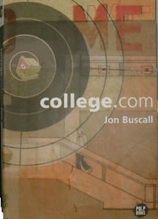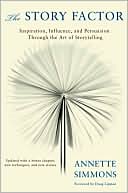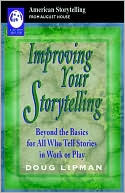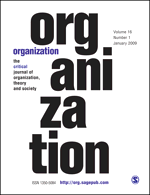Here is my first of what I hope will be several offerings about one-third of International Organizational Story Weekend, specifically the 9th annual Golden Fleece Day. This was the third Golden Fleece Day I’ve attended, and they just get better and better. For those who love and use applied storytelling, this event is so rich and nourishing. Almost too rich; for each of the three sessions for which participants (who came from all over the world, by the way) could choose a breakout workshop, four breakouts were available. It was so hard to choose! I would have loved to attend almost all of them. I should also note that I left the event early to attend a wedding, missing the last set of breakouts, the closing session, and one other session.
I should probably also point out — as if it weren’t obvious — that my photography skills are far from stellar. (If you are the subject of any of these photos and don’t want yours published, let me know, and I’ll take it down.)
Chris Heimann (pictured at right) of the UK’s Sparknow kicked off the day, describing himself as “emcee.” I’m more inclined to see him as a facilitator, or, given his theater background, our director. Chris’s mission was to “charge the space of collaboration” for the day, which he accomplished by leading us through some theatrically based improvisational activities that he described as “games and exercises … that help us get into a useful state of mind; a state of mind to do with openness, curiosity and presence.” He explained that these actions would enable us to enter into stories of the day because actors “make sense of the world through action.”
Chris told us we were in the story of Golden Fleece 2009, that we were the characters creating the narrative of the day. As you can see in the photos below from these activities, they involved circling around the room en masse and interacting with other attendees.
 These activities thus became a profoundly palpable demonstration of the concept of socially constructed reality as participants began to construct the day.
These activities thus became a profoundly palpable demonstration of the concept of socially constructed reality as participants began to construct the day.
I had the extreme honor of having as one of my partners during these activities Paul Costello, director of the DC-based Center for Narrative Studies, who was also the morning keynote speaker. As part of one of our activities, I suggested that Paul and I take photos of each other. See the results below: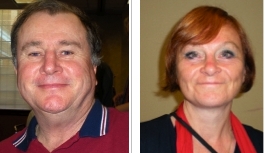 Paul’s presentation echoed the theme of Golden Fleece Day — “Why Story Matters More than Ever: Exploring Contemporary Challenges,” and the passion and skill with which he delivered his talk mesmerized the audience. He began by saying, “We story our lives into meaning, and meaning informs our choices and our actions.” He suggested we ask ourselves what story brought us in the door of the conference — the story that would explain for each of us personally why we were sitting in that room in the National 4H Center in Chevy Chase, MD. Australia-native Paul also explained that the ideas that gestated in his talk at last year’s Golden Fleece had resulted in a book, The Presidential Plot, about storytelling in the 2008 election.
Paul’s presentation echoed the theme of Golden Fleece Day — “Why Story Matters More than Ever: Exploring Contemporary Challenges,” and the passion and skill with which he delivered his talk mesmerized the audience. He began by saying, “We story our lives into meaning, and meaning informs our choices and our actions.” He suggested we ask ourselves what story brought us in the door of the conference — the story that would explain for each of us personally why we were sitting in that room in the National 4H Center in Chevy Chase, MD. Australia-native Paul also explained that the ideas that gestated in his talk at last year’s Golden Fleece had resulted in a book, The Presidential Plot, about storytelling in the 2008 election.
 But this year’s story is very different. The current economic climate reveals three crises, he said — one of truth and honesty, one of fairness, and one of meaning. Paul drew a parallel; after 9-11, we knew we had to tell the stories, and they would help us to heal. But our current crisis is storyless, not unlike the famine in Ireland in the 19th century in which 2 million people died. The Irish have never told the famine story.
But this year’s story is very different. The current economic climate reveals three crises, he said — one of truth and honesty, one of fairness, and one of meaning. Paul drew a parallel; after 9-11, we knew we had to tell the stories, and they would help us to heal. But our current crisis is storyless, not unlike the famine in Ireland in the 19th century in which 2 million people died. The Irish have never told the famine story.
The storylessness of the current crisis is in part, Paul said, because there is no “I;” in other words, no one is taking responsibility. He went on to provocatively suggest that Bernie Madoff is the only hero in the current story because he said, “I am guilty.”
For the first breakout session, I chose the workshop entitled “Getting Back to Storytelling Basics” presented by advertising and marketing guru Gerry Lantz of STORIES THAT WORK. This was the session that probably gave me the most pause, food for thought, and practical application for my work with storytelling in the job search. As I mentioned in a previous post, Gerry noted that when “nearly any verbal recounting is labeled a ‘story’ … therefore nothing is a story.” He argued for well-structured stories as opposed to Situation-Action-Result (SAR) (“yawn,” he said of this formula).
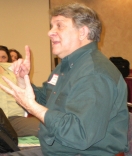 Given that part of my book, Tell Me About Yourself, advises using variations of the SAR story in the job search, Gerry’s talk made my head buzz with great ideas for telling a more compelling and well-structured story. The question that Gerry suggests should undergird all stories is: “What’s at stake?” I think in my next edition of my book, I need to talk more about well-structured stories and incorporate some of Gerry’s ideas. I loved the fact that Gerry illustrated his techniques by having audience members tell stories. My heart was pounding with a need to tell mine, but it was rather personal, and I chickened out.
Given that part of my book, Tell Me About Yourself, advises using variations of the SAR story in the job search, Gerry’s talk made my head buzz with great ideas for telling a more compelling and well-structured story. The question that Gerry suggests should undergird all stories is: “What’s at stake?” I think in my next edition of my book, I need to talk more about well-structured stories and incorporate some of Gerry’s ideas. I loved the fact that Gerry illustrated his techniques by having audience members tell stories. My heart was pounding with a need to tell mine, but it was rather personal, and I chickened out.
Gerry’s talk was also a learning process for himself. My new friend and next Q&A subject on A Storied Career, Thaler Pekar, had suggested to him the day before that he ditch his PowerPoint slides for his talk (many storytellers support the idea of “stories, not slides”). He had clearly modified his slides, and it was clear he was considering making them even more minimalist or getting rid of them in the future.
At lunch, I sat with two special folks, Craig DeLarge, and Lynne Feingold. Craig is the person I “recruited” to come to the conference, and I was so proud to watch him interacting with the luminaries of organizational storytelling. He and I have lots in common, and he has a diverse and fascinating background that touches on marketing, storytelling (a major focus of his master’s thesis at the University of Westminster, UK), and career development. And that’s one of the bridges between him and Lynne, whose father, Norman Feingold, was a prominent figure and prolific author in the world of career development. Lynne is also one of the pioneers of the organizational storytelling movement, a founding member of Golden Fleece, long-time host of Golden Fleece meetings, and still sometimes the host.
Here I should add that I talked to story folks I’d talked to before, as well as new ones I met on this day. Madelyn Blair introduced me to Julie Wickert, who had told Madelyn she is a fan of A Storied Career. I also met Debbie Witt and wanted to talk with her further, so Debbie, if you’re reading this, please reach out. Pictured below, left to right, Craig DeLarge, Lynne Feingold, Julie Wickert as I photographed her at Golden Fleece (far right), and because it’s not a great photo, a better photo of her from her Web site, True Story Communications:
 After lunch we experienced a treat that was new to me as a Golden Fleece attendee — a concert by singer-songwriter Laura Baron, whose newest CD is “From The Avenue.” Laura, married to change-leadership expert Seth Kahan, brought the house down with her rollicking tune “The Laundryman.”
After lunch we experienced a treat that was new to me as a Golden Fleece attendee — a concert by singer-songwriter Laura Baron, whose newest CD is “From The Avenue.” Laura, married to change-leadership expert Seth Kahan, brought the house down with her rollicking tune “The Laundryman.”
Then it was Seth’s turn. His mission was to help participants to process the morning’s sessions, which he did by taking us through some conversational/storytelling steps, first with a partner and then with the whole group, that culminated in a profound discussion responding to the question, “What is the unique contribution we can make to the world today?”
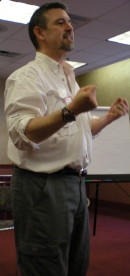 I was privileged to have as my conversation partner Kelly Cresap, whose session on archetypes I attended at my very first Golden Fleece in 2005. We had just the loveliest conversation. One of the most significant influences on his recent life has been his intense study of the book Daniel Martin by John Fowles, which he has
I was privileged to have as my conversation partner Kelly Cresap, whose session on archetypes I attended at my very first Golden Fleece in 2005. We had just the loveliest conversation. One of the most significant influences on his recent life has been his intense study of the book Daniel Martin by John Fowles, which he has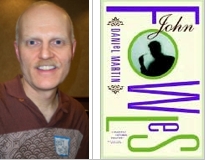 read 10 times. Kelly’s pictured at right with the book.
read 10 times. Kelly’s pictured at right with the book.
The final breakout I attended was led by my friend and fellow Central Floridian, Rick Stone, also one of the founders of organizational storytelling. Rick shared a technique called StoryJam that his company, i.d.e.a.s., charges big (really big) bucks for. Just another of the myriad examples of the generosity of the storytelling community — freely sharing a technique that some companies would consider proprietary and never dream of sharing.
So many stories, so many wonderful people to talk to, so many fascinating-sounding breakout sessions — so little time, especially given my hasty departure. I would have loved to talk to lots more people and attend lots more sessions. I would have loved to attend the sessions of both the ever-fabulous Madelyn Blair (pictured at left in the photo below) and Noa Baum (at right below), about whom I’ve heard so many wonderful things.
 Kudos to conference chair Denise Lee and all the organizers. Can’t wait till next time I attend, probably 2011. In the meantime, I’d love to connect with any others who are blogging or Twittering about the conference. let me know what you’re saying and where to find it so I can share with readers. Oh, and I guess I misspoke with the headline of this entry; I thought it would be more pictures than words, but it has turned out to be the opposite.
Kudos to conference chair Denise Lee and all the organizers. Can’t wait till next time I attend, probably 2011. In the meantime, I’d love to connect with any others who are blogging or Twittering about the conference. let me know what you’re saying and where to find it so I can share with readers. Oh, and I guess I misspoke with the headline of this entry; I thought it would be more pictures than words, but it has turned out to be the opposite.
Ray Jimenez has blogged about Storytelling Weekend here.
Madelyn Blair blogged here (you probably need to join the Ning group Worldwide Story Work to read it (Well worth it, by the way.)
Beth Stoner blogged about the weekend here.
figuring out what the story should be through tips for how to recall stories stored in your brain! (For example, give your stories names.) It is full of samples of stories and many, many ideas that are critically useful for job seekers and all professionals. … If you’re engaged in a job search — or maybe you should be — don’t miss this great resource!













